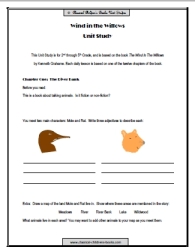
Wind In The Willows Unit Study
The Wind In The Willows Unit Study for 2nd through 5th grade is based on the book by Kenneth Grahame.
Free Printable Download Below
There are film versions of the Wind In the Willows. Unit studies often include watching films after the books is read.

Chapter One - The River Bank
Before reading the first chapter, discuss fiction and non-fiction. If a story has talking animals, which would it be?Read the chapter. This can be read out loud, together as a group, or assigned individually.
The two characters you met in this chapter are Mole and Rat. Write three adjectives to describe them.
Extra: Draw a map of the meadows, river, river bank, lake, and wildwood. Use the description in the book to place each of these locations.
Chapter Two - The Open Road
Vocabulary: Fickle - an adjective to describe someone who changes their mind or opinions frequently.Before reading the chapter, introduce the idea of fickle. Tell them they will meet a new character who is fickle. Ask them to find out why they are fickle.
After the reading, discuss what makes Toad fickle. He keeps changing his interests. Name and draw the three interests mentioned in this chapter (boats, carts, motor cars.)
Draw the three vehicles Toad has liked. You can also use basic shapes from construction paper to construct them.
Match characteristics of real moles, rats, and toads with the descriptions on the unit study page. Students can also construct quizzes for others.
Dramatic Reading: Ask someone to read the 22nd paragraph (which starts with "There you are") as dramatically as Toad would have spoken it.
Chapter Three - The Wild Wood
Pre-activity: Discuss what it is like going outside, alone, on a scary night. How do you feel?In this chatper, Mole goes out into the Wild Wood alone at night. Things scare him. He was afraid of "them." Who do you think "them" might be?
Draw eyes staring at you from the dark. Use black construction paper with white chalk or paint.
Grammar: Compare the subjective and predicative form of personal pronouns.
- them/them
- he/him
- she/her
- we/us
- you/you
- I/me
Chapter Four - Mr. Badger
Write a description of a comfortable home on a snowy winter night.After reading the chapter, write three adjectives that describe Badger.
Research and write three facts for ONE of these animals discussed in this chapter: badger, otter, hedgehog.
Some animals hibernate in the winter. Do an internet search to find about another animal that hibernates throught winter months.
Draw a sketch of Badger's home. Include at least four details from the chapter.
Chapter Five - Dulce Domum
The title of this chapter comes from Latin. Dulce means sweet, and domum is home. It could be translated, "Home, Sweet, Home."Make your own Home, Sweet, Home sign. You can choose Latin or English words.
Badger, Mole, and Toad had grand homes. Describe Mole's home.
Think of a familiar object or familiar place to you. What is it? Why is it comforting? Can you write a descriptive paragraph making it sound comforting?
Re-read the last two sentences of this chapter to someone out loud. Read with expression.
Chapter Six - Mr. Toad
In this chapter of The Wind In the Willows Unit Study we encounter Mr. Toad again. We will also discuss the plot of the story.Introduce the concept of plot as the series of events of a story. Each chapter also has a plot. After reading the story, list the plot of chapter six.
Vocabulary: Gaoler is a jailer. Hmmm, sounds like a pretty mean jailer, doesn't it?
Drama: Have an adult or strong reader read the third paragraph from the end, as a student acts out each part.
Read the last paragraph of the chapter again. Do you feel sorry for Toad?
Chapter Seven - The Piper at the Gates of Dawn
Vocabulary:Piper - a person who plays on a pipe. In some ancient stories pipers were sometimes considered to have mystical powers.
Weir - a dam to raise the level of water in a river.
This chapter is like a dream. Do you think the animals are dreaming? Discuss what evidence would suggest it is a dream, and what evidence would suggest it is not.
Poetry: End the seventh lesson of the Wind in the Willows Unit Study with poetry. The last few paragraphs have a poem that is mixed with words describing what is happening as nature whispers the poem. Here it is listed without the extra words. Take turns reading it orally.
Lest the awe should dwell and turn your frolic to fret
You should look on my power at the helping hour
But then you shall forget!
Lest limbs be reddened and rent, I spring the trap that is set
As I loose the snare you may glimpse me there
For surely you shall forget?
Helper and healer, I cheer small waifs in the woodland wet
Strays I find in it, Wounds I bind in it
Bidding them all forget!
Chapter Eight - Toad's Adventures
This part of the Wind in the Willows Unit Study returns to Toad's adventures and misadventures. Read the chapter.List and discuss the 3 different adventures that Toad had in this chapter.
Imagination Time: Write, draw, or act out a skit telling how you would escape if you were captured.
Chapter Nine - Wayfarers All
In this part of the Wind in the Willows Unit Study, a sea faring rat comes into the tale.Vocabulary: Wayfarer - a traveler.
Discussion: Have you ever been a wayfarer? Would you like to always be a wayfarer?
Read the chapter. The animals are restless. What do they want to do?
Discuss migration. Identify which of these animals migrate every year: geese, whales, snakes, seals.
The Sea Rat described his life going from port to port. Write a description of the life of another migrating animal, told from the animal's point of view.
Opinion Please: is it easier to write fiction or non-fiction. If you were to write a book about the migration of an animal, would you rather write it as a fiction story, or a non-fiction book?
Chapter Ten - The Further Adventures of Toad
Vocabulary: Pride - a high opinon of one's importance or superiority.Make a chart of Toad's pride. Why does it go up and down?
Discuss: Should Toad be proud of himself? Is he thinking of others?
Writing: Toad has a high opinion of himself. What do you think the other people's opinion would be. Write a description from one of them.
Chapter Eleven - Like Summer Tempests Came His Tears
Read the chapter. Discuss what has happened to Toad's home.Let's Vote:
- I feel sorry for Toad.
- Toad deserved it.
Vocabulary: A tempest is a storm.
Summer storms often come quickly. What does this chapter title mean?
Choose one of these three animals that are antagonists in the story:
- Ferrets
- Weasels
- Stoats
Make a puppet of your animal. As part of the Wind in the Willows Unit Study, let the puppets tell the story of what happened at Toad Hall.
Chapter Twelve - The Return of Ulysses
We have come to the last lesson in the Wind In The Willows Unit Study.Ulysses was a hero in ancient Greece who was gone for a long time, and then returned to his city in triumph and defeated his enemies there. Why do you think this chapter is called "The Return of Ulysses."
Toad was never able to give his speech to his friends and his neighbors. Let the students write the speech they think Toad would have given.
Discussion: Has Toad changed? Has Mole changed?
Consider: Toad was proud, and now he has been humbled. It remains to be seen if there is really any change. Mole started very humble, but now has gained confidence. He, however, is not arrogant.
Conclude the Wind In The Willows Unit Study with a class vote: My favorite character was.....
Download the Wind In The Willows Unit Study
Get Your Printer Ready. You will need 12 pages printed. The orientation is Portrait.

Click to download. A new window will open.












